|
DEFINITIVE
XPOSITION
The untold story of Raiden DX
Here at World
Of Stuart, we're all fans of selectively-popular videogame magazine
Edge. Over its 11 years of so
of publication, it's consistently provided a little oasis of intelligent
and thoughtful discourse in the fetid swamp of irredeemably
corrupt, sub-teenage drivel which passes for the games press. It also - at least until recently - could be counted on for honesty and integrity in its coverage, a fact demonstrated at the end of 2003 when almost the entire editorial staff resigned rather than submit to interference from the magazine's management aimed at curbing the writers' ability to express opinions which might affect its publisher's revenues by upsetting advertisers. However, in its entire history, and throughout
many changes of its anonymous personnel, there's been one other consistent factor in
Edge - its reviews are absolutely terrible.
From giving the
original Doom 7/10 because you couldn't hold conversations with the
monsters instead of shooting them (no, really), to awarding the legendary
Gunstar Heroes a miserly 6/10, to the mysterious
case of Grand Theft Auto 3 (where the game got a short, lukewarm review
and another 6/10, passed off in the next issue as a "printing error" and
amended to a still-absurdly-stingy 8) and right up to their abysmal
treatment of the magnificent Wario Ware Inc - the best and most inventive videogame of the
last two years, and one containing precisely the things Edge claims to be
looking for in games, yet which got a piddly half-page review written by
someone who didn't understand the concept and gave it 7/10 - Edge's
reviews have long been the mag's Achilles heel.
Either hopelessly
misjudged or loaded with factual errors, and quite often both at once, Edge
reviews can practically be guaranteed to turn out to be entirely wrong
when seen in the cold light of history, or even the cold light of the next
month's issue. Which brings us, if you were wondering where this was
going, to Raiden DX.
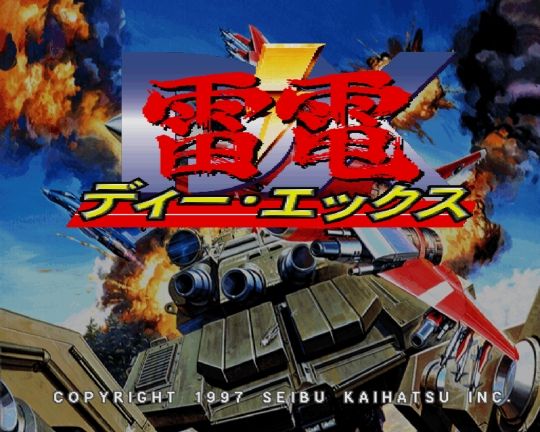
Japanese writing: weird.
A 1997
Japanese-only Playstation conversion of a 1994 coin-op, Raiden DX was
reviewed in Edge's June '97 issue, in a small piece which dismissed it as
"little more than a subtle reworking of Raiden II from the
original Playstation disc...which staggers the
full suite of levels between training, novice and expert modes, and in
which the only visible enhancements are tweaks to backgrounds and some of
the boss animations". The reviewer clearly wasn't impressed and
awarded a score of 6/10, which would be fair enough if the quotes above
weren't entirely factually wrong in every possible regard.
Raiden DX is, in
fact, no more a "subtle reworking" of Raiden II than GTA:Vice City is a
"subtle reworking" of GTA3. It's a significantly new Raiden game - though
unsurprisingly one in very much the same vein as its predecessors - with a
bunch of new levels, stacks of new features and some significant changes
in the gameplay. (Furthermore, the training mode doesn't in fact contain
any of the levels from either Raiden II or the normal Raiden DX game, but
we'll get to that in a bit.) It's a far superior game to Raiden II, it's
one of the best and most perfectly-balanced vertically-scrolling shmups
ever created, and it deserves better than to have practically the only
piece of coverage it's ever received in the UK be so woefully inadequate
and wrong. Lucky WoS is here to put the record straight, eh chums?
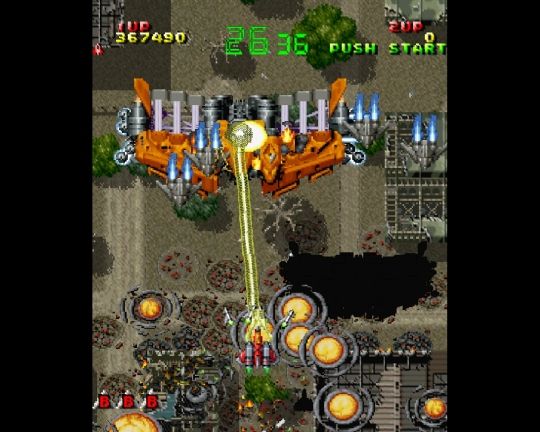
We're sure the people of the countryside below are grateful for their liberation.
Before we start rambling on about how great Raiden DX is, it's worth spending a little time on the game's structure, in order to illustrate just how much more there is here than a slightly tweaked re-release of Raiden II. At the start, you can select from three basic games. Novice mode is a short game made up of the first five of Raiden
2's stages, but with one important gameplay change that we'll get to
shortly, while Expert mode is a full-length game with eight entirely
new levels (except that each stage has the corresponding Raiden 2
boss at the end) plus an Extra Stage which is unlocked by the
superhuman feat of clearing the first eight levels without using a
continue.
The third option,
however, is one of Raiden DX's most noteworthy innovations. The
misleadingly-named "Training Stage" is a single all-new level,
around 15 minutes long and with only one boss, right at the end.
Unlike the rest of the game, no continues are allowed, and no 1UPs
are available - you get three lives with which to battle all the way
to the end, and if you blow it there are no second chances. Despite
the billing, this is full-on Raiden, no easier than the normal
games, and it'll be a long time before you make it through your
"training" in one piece. It's perfect burst gaming, hugely addictive
but also ideal for when you just want to blow things up in a highly
satisfying manner for half-an-hour rather than start wading into
some weeks-long epic RPG quest or exhausting stealth FPS.
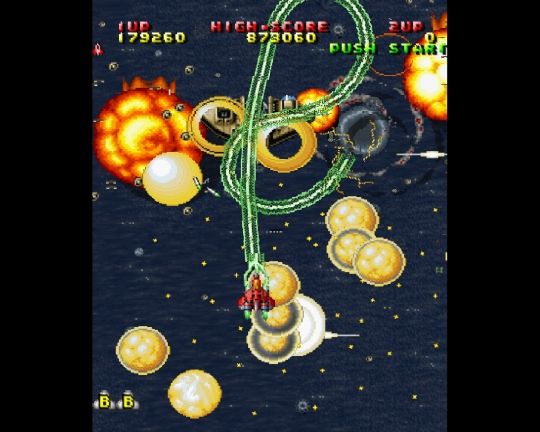
You'd think they'd take the hint, wouldn't you?
If the Training
Stage was the only new addition in Raiden DX, it'd frankly still
make the game worth buying for owners of the Raiden Project release.
But in fact there's a lot more to RDX than that. Playing and beating
the normal games unlocks all sorts of extras, including a beautiful
gallery mode in which you can view all the major player and enemy
vehicles and installations in full moveable-camera 3D, right down to
changing the lighting. More interesting, though is "Master Of Raiden",
a demonstration performance by the CPU on the full Training Stage,
which you can watch in order to feel totally depressed about your
hard-won high score, as the PS illustrates
how you could actually have racked up six times as many
points without breaking sweat or even changing from the initial
weapon. (The CPU completes the entire stage with only the basic
powered-up Vulcan cannon, just to rub in your laser-using-nancy-boy
inadequacy.)
The key to the
CPU's big scores on the Training Stage is the same as the key to big
scores in the normal games, and is the core gameplay change
mentioned earlier between the previous Raidens and Raiden DX. In the
first two games, destroying certain ground targets reveals a medal
(either gold or blue) which can be collected for instant points, and
also affects your bonus at the end of each stage (where you get a
bonus comprising 1000 points, times the number of medals collected since you
last died on that stage, times the number of smart bombs you have
left). However, in the earlier games, the medal just sat there and
waited for you to collect it for a set number of points (eg 500 for
a gold). In DX you get the same end-of-level bonus, BUT the medal's shine begins
to swiftly fade the moment it appears and the instant points
value for collecting it decreases accordingly, down to just 10 points if you delay picking it up for three or four seconds until the point where it
loses all its gleam and turns grey. But there's a twist.
A couple of seconds
after the medal has first faded to grey, it flickers momentarily
back to full power, at which point a gold medal will net you a big
3,000 points, and a blue one a whopping 10,000. Given that there are
a couple of dozen medals in a typical stage, and a total game score
of 1 million is a pretty impressive achievement in Raiden, the
attraction of a potential 100,000 or so extra points per stage is a
major temptation. And that finally leads us to just why Raiden DX is
such a great game. (And why Edge reviews are so hopeless.)
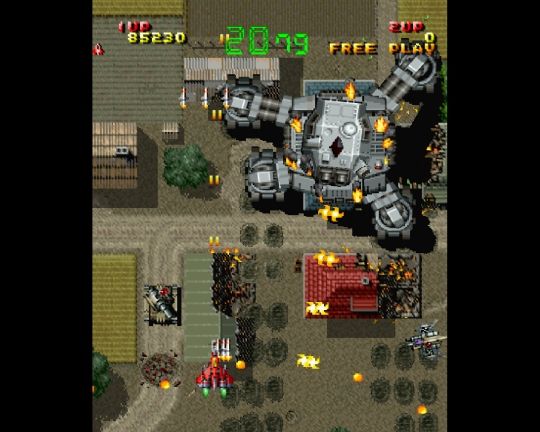
All that money on armour, and hardly any left to bolt on some guns. Poor little enemy boss.
The main reason
Raiden DX, even when compared to its own predecessors, so admirably
still represents the state of the art in game design even a decade
after its release, is that the key to good videogame design - in
any type of videogame - is the delicate balance between risk and
reward. The Raiden games, particularly RII, were already accomplished in this regard. (The first game less so, since when you die the game stops and moves you back a little way, rather than continuing uninterrupted amid the same hail of fire that killed you.) The most
critical points in Raiden II aren't when you meet the big bosses,
but the moments after you die, when you have to decide whether to
just quickly and blindly grab all the power-ups released by your destroyed ship
(running the risk of ending up with a hopelessly underpowered
weapon, since collecting two differently-coloured powerups
consecutively will change your weapon without increasing its
strength), or whether to dodge frantically around in the continuing
enemy onslaught until the powerups agonisingly-slowly cycle round to the
right colours, whereupon you'll have enough firepower to have a
decent chance of getting back on top of the baddies.
Raiden DX takes
this theme and expands it enormously, with the single simple
addition of the decaying bonus medals. Now, from only having to make
the risk-reward decision (and the skilled manoeuvring it requires)
when there are powerups to collect, you have to make such decisions
more or less constantly (since there's rarely a moment in the game
when there isn't either a medal or a powerup on screen). The frequent
occasions when there are both, and you have to plot and navigate a
perfectly-timed path, through a blizzard of fire, to collect a
moving powerup while it's the right colour and a
fading medal in the tiny fraction of a second that it's worth the
big points, may well blow a fuse in the brain of anyone who isn't
extremely good at spatial mathematics under extreme pressure. It's
the videogaming equivalent of talking someone through solving a
Rubik's cube down a mobile phone in a foreign language while you're
running across a rickety rope bridge over a 300-foot river canyon
juggling Molotov cocktails, as 500 angry Aztecs fire arrows at you
from both sides.
(Of course, you
could just pick the medals up whenever, stay alive and only get
1/300th of the points. But if you're not trying for the high score,
why are you bothering to play the game at all, you wimp?)
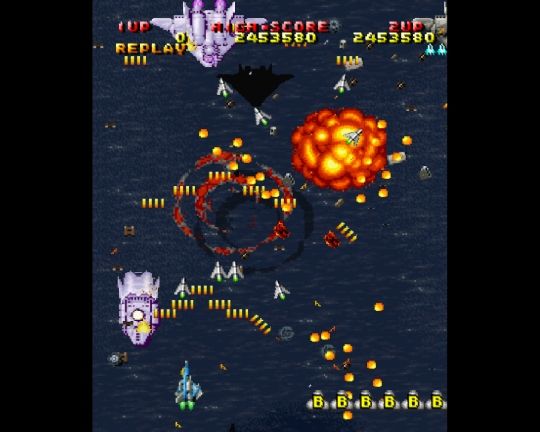
A cameo appearance from the little-seen Player Two, there.
Did we mention the
secret targets yet? The DX-only, Xevious-inspired little towers that
are hidden underground in all the game's modes and only pop up to be
lucratively destroyed if you happen to fly over them, giving you
another risk to take even in quiet moments? Sorry, must have
forgotten those. What about the big secret bonuses, for example the
50,000 you get every time you pick up a smartbomb powerup when you've
already got eight of the same type on board your ship, forcing
another awkward timing issue when collecting things (grab whatever
comes, or wait and dodge until the bomb cycles to the type you've
already got) and another tricky decision (about whether to use your bombs
for tough bosses and emergencies or stockpile them in the hope of a
giant points bonanza in the latter stages)? Or the way the game
judges how bravely you've played and awards a bonus at the end
accordingly, so that to score well you have to get stuck right in
toe-to-toe rather than hiding in a corner and smartbombing all the
big enemies? We didn't mention any of that? Dang.
If all that still
isn't enough challenge for you, don't worry. After more play, you'll also unlock the Special
Stage (yet another exclusive-to-DX addition), in which the nervous
player must face all ten of the game's bosses one after the other,
with generous power-ups but again without the benefit of continues,
in a round which is played not for points but against the clock (you
get awarded a "lap time" for each individual boss, and for the stage
as a whole should you finish). The only way to get on the Special
Stage's high score table is to complete it, a task which will keep
even the most hardcore expert shooter busy for many an hour.
Raiden DX's
high-score tables themselves are pretty uncompromising in general. Unlike
some lily-livered recent shooters, you don't get to enter your name
if you continue - your score still appears on the table if you get
enough points on any particular credit, but under the name "=C=".
The only way to get a proper, credited high score is to take the
game on from the start - and don't think you can cheat by ramping
the difficulty down either, because DX keeps and saves separate
tables for each mode and for each of the five main difficulty settings.
(Which are rather cruelly denoted Easy 1, Easy 2, Easy 3, Normal and
Arcade.)
However, if all this sounds terrifying
and you think the fancy bonus stuff might as well not be there
because you'll never unlock it in a hundred years, don't panic. The
lowest difficulty setting - Very Easy - pioneered a feature that's
now quite common in modern shmups, whereby you tackle the level as
normal except that absolutely none of the enemies are allowed to
fire at you. Obviously, this makes it somewhat simple to beat
the game in one credit and thereby unlock all the extra content, and
then you can put the difficulty back to something more grown-up
without having the high-score tables disfigured by your cheating.
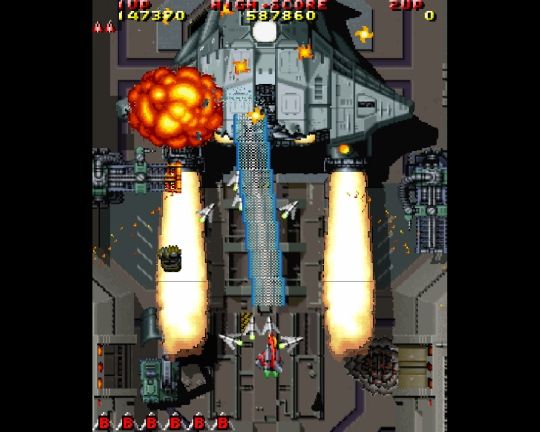
The blue straight-ahead laser looks oddly wimpy in screenshots, but isn't.
Interested yet? Of
course, the point of this feature is that these are only the traits
and characteristics that are exclusive to Raiden DX. This piece
doesn't even touch on any of the excellent qualities that are shared
by all of the Raiden games - the simple, well-balanced
selection of weapons, the timeless graphics, the relentless action,
the painstaking fairness of even the most demanding enemy attacks,
the full-blooded sound and the memorable music. Heck, we haven't
even mentioned the inclusion (pioneered in Raiden II) of the single
best weapon in shoot-'em-up history, the purple Plasma Laser
(variously known to dedicated Raiden aficionados as either the
"Wiper Laser" or, more picturesquely, the "Toothpaste Laser"). The
appreciation of that particular work of art will have to wait until
another day.
Naturally, here at
World Of Stuart we understand the difficulties faced by fellow
journalists in trying to convey the amount of information contained
in a sprawling, extensive piece like this one in a tiny 150-word
round-up review in a busy working month, especially when it's of an
obscure import game that almost none of your readers are likely to
be buying anyway (or indeed, would be able to buy even if they wanted to).
But when you haven't got room to say much, you really ought to make
sure that at least what you DO say isn't totally wrong. Games as
good as Raiden DX deserve to be treated with a little more respect
than that.
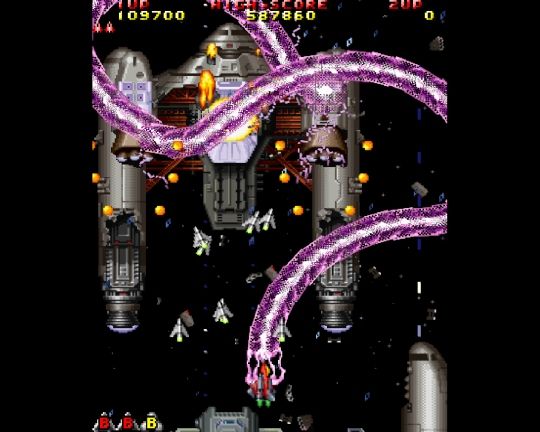
The mighty Toothpaste Laser, seeking out enemy "plaque" with tireless vigour.
(All of this, of course, is somewhat academic, since the chances of
anyone being able to locate a copy of Raiden DX and discover its
majesty for themselves now are significantly worse even than they
were in 1997. It's a particular shame given that the game runs so
well in Playstation emulators like
ePSXe. If only the 81MB
zipped BIN/CUE file, which the emulators will run directly without
it having to be burned to a CD first, could be even briefly
available for download, so that people could play it and share it on
P2P networks and ensure it wasn't lost to history forever,
eh?)
|

